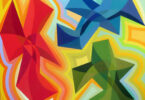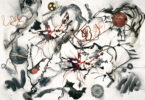Oscar Wilde once said, “Memory…is the diary we all carry about with us.” In the exhibit, “Memories,” curated by Basha Maryanska, seen recently at the New Century Artists Gallery, eleven artists provide intimate journals of the emotions and memories of their interior lives in vibrant colors. Maryanska plumbs her psyche to provide soulful impressions of places she has been. Although her images are abstract, they make reference to cities, such as Paris, perhaps on a rainy evening, Las Vegas, with nighttime glowing lights and Santa Fe, nestled in the foothills of the Sangre de Cristo Mountains. Her colorful, mixed media piece, “Memories,” is a tour-de-force with pigment scumbled, scratched, splattered and washed on a linen surface. The effect is textural and almost geologic where I am reminded of mountainous rock forms in the midst of an intense storm.
The painter and sculptor, Kathryn Hart presents her intimacies in all their raw power. Combining found objects with painted surfaces, her work is dramatic and sculptural as she examines the vulnerability of human beings with work incorporating canvas and cloth, with gashed, torn surfaces in her dense, dark pieces, reminding us of the human soul at midnight in a most solitary place where phantasms come as in the dreams of Francisco Goya. A surgeon’s daughter, she is influenced by the techniques of that discipline as evidenced in her mixed media collage with objects entitled, “Barbarians at The Gate” where layers and lines of protection against an invading, threatening force desperately defend the subject through a broken, barred wooden gate, surgical strings curled like mine field wires, and painted burlap suggesting gauze staunching a wound, keeping the psyche safe from menacing memories.
Paola Bari’s interpretations of memories are in contrast to Hart’s—whimsical, fanciful porcelain painted tiles of the natural world in her depictions of cats, great and small, and the tiny denizens of the garden. Her tiles glisten with color and textures and her drawings of flowers and insects have an almost Japanese sensibility where she flattens the surface against the background tile colors, juxtapositioning detail with color. She humorously depicts the “Four Seasons” through highly stylized fashion heels, primarily painted with a complementary palette and drawn with a strong sense of pattern coming to the forefront in the design. A more relaxed, rendered piece, “African Landscape” allows Bari to paint with mostly loose swaths of color depicting the landscape on which she has superimposed a woman walking in silhouette on the road at sunrise, perhaps going to market. All of her pieces show a broad range of ability in drawing and composition.
The expressionistic paintings of Maria Maciega conjure up in me memories of work from two different art movements. The thick, impasto profiles and full faces Maciega paints in her “Cycle” pieces bring to mind both David Park and Karl Schmidt-Rotluff in their subject matter and compositions. She presents an ambient vagueness in her painting “Autumn” where the trees are almost ghostly, anthropomorphic images realized in attenuated paint strokes in Fall colors. The acrylic on canvas, “The Four Seasons Polyptych” has a cosmological feel with great energy in the applied paint surfaces as she truly provides impressions from the mind’s eye.
Elaine Weiner-Reed’s abstract figures bear an affinity with the legacy of Willem de Kooning. Her gestural entities display emotive linework, mining human emotions in energetic drawing, evoking deep feelings and memories, contrasting the strong black lines of the human form with softer, semi-ephemeral color washes with abstract expressionist sensibility.
Bozena Wiszniewski interprets the Australian landscape in simplified, spiritual abstracts conjuring up Rothko, Avery and Dove. Her palette is almost monochromatic, with an overall feeling of unity and rest. “Ocean and Lakes” is a quasi-color field piece with a reference to the exterior world, reinterpreted by the artist as almost palpable memories of nature. Wiszniewski uses line minimally to support the painted forms, all serving to highlight the naturalness of the land and sea.
Katia Gerasimov is an abstractionist whose concentration on color brings forth memories of particular places. She is world traveled and the colors, textures and atmospheres of all the frequented places have influenced her paintings in her interior pictures that are geometric in execution, as in “Terra Cotta” or diffused as in “The Grotto.” Her oil “Moonlight” is particularly striking for its moody, mysterious scumbling where the viewer feels she is looking up at a tranquil night, the moon’s subtle image faintly discerned in the dark, clouded sky. In contrast, drops and squiggles of paint, reminiscent of Mark Tobey’s work, cover the canvas in “Kilim,” bringing a tension to the picture, animating the palette colors. With a technique employing drawn, whirled incising into the acrylic surface, “Ribbons” exposes a mottled underlying collage, creating intensity in comparison with the work’s subtle coloration.
Maureen S. Farrell’s experience as an artist has informed her work with a unique perspective that integrates a broad range of watercolor techniques with other media. Her work delves into memories resulting in spontaneous, sometimes autobiographical paintings, particularly in her mixed media collage, “Crossing the Bay” where ghostly, black painted figures seem to forge their way across the body of water off the Maryland coast, the artist’s home base. She superimposes the figures on the collaged map in the piece, contrasting the strong movement of the black strokes with the immobility of the printed map to great dramatic tension. The painting is authoritative, energetic, and in the execution of the figures, I am reminded of the power of Picasso’s drawings of bullfights.
Beata Pflanz is multifaceted as an installation artist, poet, and painter. The world around her inspires her to reinterpret it through a wide range of techniques and subjects, creating an organic reality based upon memory and the interior life. Some of her works are atmospheric with diffused color; others are semi-cubist where she shatters the picture plane as in “On the Other Side of the Mirror II” where the smooth surface of a mirror is splintered into geometric shards. In the painting, “In Between,” the maelstrom of forms is galvanized into a cohesive whole by the boldly painted arrow in the piece. Her ambitious house exterior, “I Live in My Own Painting” employs all her gifts of color and composition and when I look at it, I think of the body of work by the architect/painter Friedensreich Hundertwasser. “
Daniel Lai is witty and ironic, where memory becomes commentary on intellectual pursuit. Lai’s wall sculptures are a critical eye, warning the viewer that it is dangerous to “think truly,” His pieces debunk the status quo where his subjects, sculpted figures, resting on books opened in various contortions, have cracked surfaces as if their bodies were deformed by the plethora of information surrounding them. “Beware of What Your Read,” shows the figure reading, propped on top of a book opened in reverse, the cover ominously sprouting shark’s teeth, as if the open jaws were about to swallow the subject in a morass of information. Lai seems to say real thoughts are dangerous and revolutionary, upsetting to the unimaginative mind.
Kellee Wynne-Conrad paints with vibrant color in acrylic and oil pastel. Her floral images are impressionistic, expressive and referent to happy memories. The colors flow and the flowers burst upward from their stems, dripped and drawn on the canvas’ surface. In “Sunshine,” her purple tulip-like blossoms reach toward the lightness of the top of the canvas where complementary yellow intimates sunlight nurturing the radiant blooms. Her roots are found in the ambience of warm California, cheerfully infusing her soul and manifesting in her work.
In this exhibit, all eleven artists interpreted memories in an expressive gamut, sometimes somber, reflective, felicitous, or ironic, documented with consummate artistic verve. Individualistic, they mounted a show rich in attitudes and styles intriguing and delighting this viewer with their range of color and subject matter




